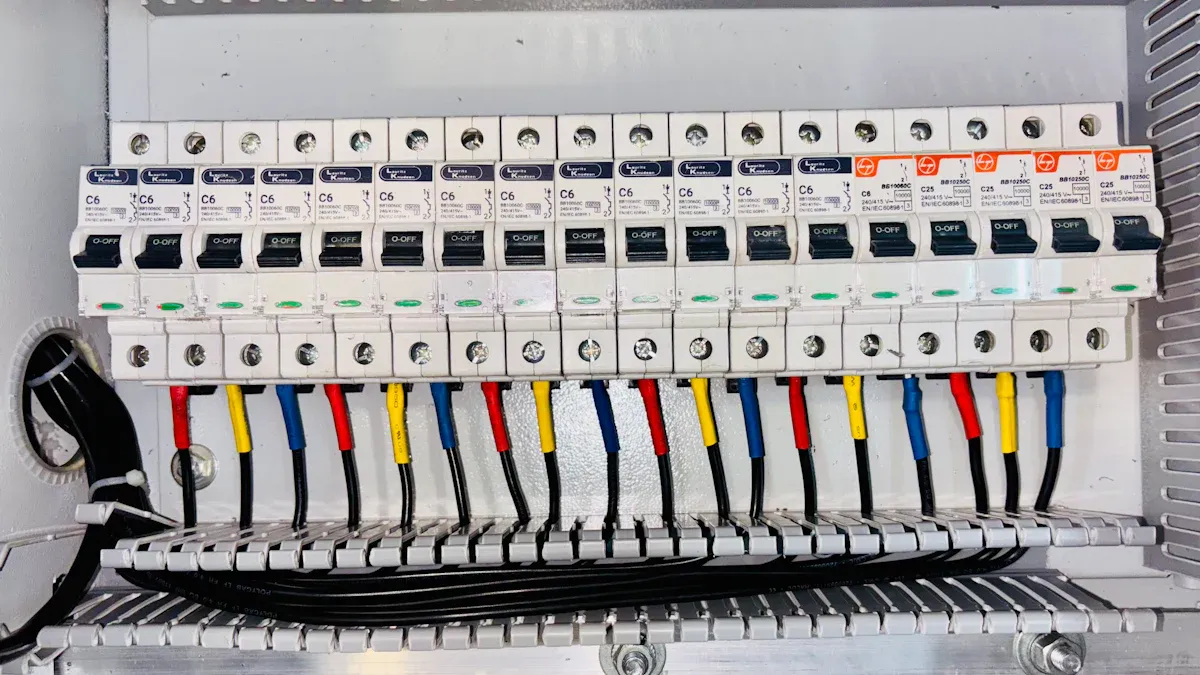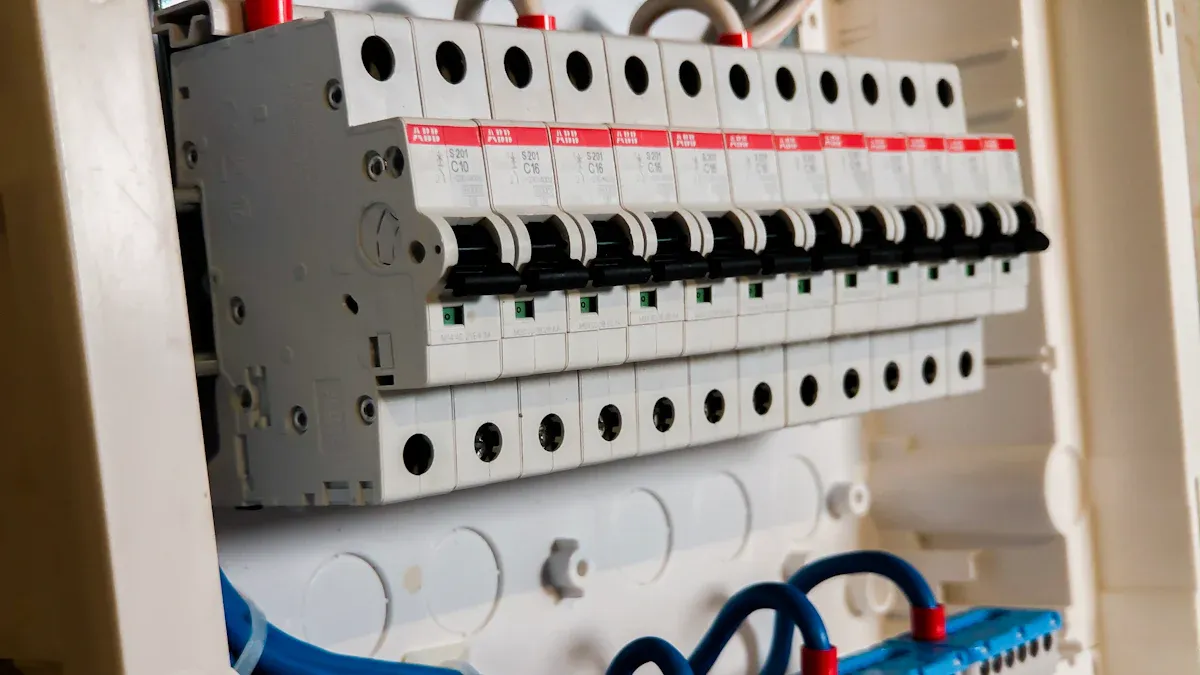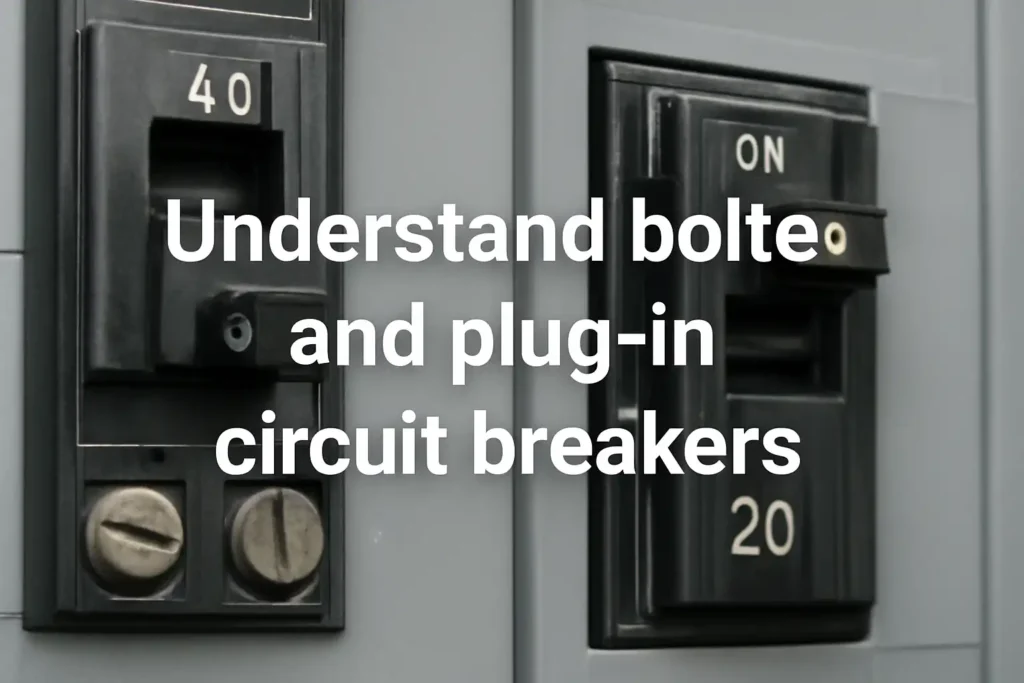Bolt type and plug-in circuit breakers keep circuits safe from too much power or short circuits. These two types connect to panels in different ways. This changes how safe and strong they are. Picking the right breaker stops electrical dangers. It also helps systems work safely. Many electricians use both types in different places. Each type works best for certain jobs.
Key Takeaways
- Bolt type breakers use bolts to connect tightly. This makes them good for factories and large buildings.
- Plug-in breakers snap in fast and need no tools. They work well in homes and small offices where speed is important.
- Picking the right breaker helps keep things safe. It also stops electrical problems like fires or losing power.
- Bolt type breakers can handle more power and do not shake loose easily. Plug-in breakers are simple to change and cost less money.
- Always look at your panel label and follow safety rules. If you are not sure, ask a licensed electrician for help.
Bolt Type and Plug-In Circuit Breakers
Main Differences
Bolt type and plug-in circuit breakers both keep electrical systems safe. They connect to panels in different ways. Bolt-on breakers use bolts to attach right to the bus bars. This makes the connection strong and steady. Plug-in breakers snap in with spring clips or stab-in parts. This lets you install them fast and without tools.
The table below shows how these two types are different:
| Feature | Bolt-On Circuit Breakers | Plug-In Circuit Breakers |
|---|---|---|
| Connection Method | Bolted to bus bars for a secure, stable fit | Snaps in with spring clips for fast, tool-free install |
| Installation Time | Longer, needs tools and careful work | Quick, no tools needed |
| Stability | Very secure, resists loosening in vibration | Less secure, may loosen in vibration |
| Current Ratings | Handles higher currents, good for heavy-duty use | Lower current ratings, best for homes and small businesses |
| Bus Bar Design | Threaded for bolts | Stab-type for snap-in |
| Maintenance | Needs tools, takes more effort | Easy to replace, no tools needed |
| Cost | More expensive, complex design | Less expensive, simple design |
| Application | Used in commercial and industrial places | Used in homes and light commercial places |
Bolt type and plug-in circuit breakers are made for different jobs. Bolt-on breakers are best for places that need a strong, lasting hold. These places include factories or big buildings. Plug-in breakers are used in homes and small offices. They are good when you need to change or fix things quickly.
Why It Matters
Picking the right breaker keeps people and buildings safe. In places with lots of shaking, like factories, bolt-on breakers stay tight. They do not get loose over time. This helps stop fires or power problems. Plug-in breakers are easy to swap out in homes. This saves time and makes repairs simple.
Note: If you use the wrong breaker, it can get loose or too hot. This can cause power to fail or even start a fire. Always use the right breaker for your panel and where you are working.
Knowing the differences between bolt type and plug-in circuit breakers helps people choose the safest one. This helps electrical systems work better and last longer.
Bolt Type Circuit Breakers

Features
Bolt type circuit breakers connect to the panel’s bus bars with bolts. This makes a strong and steady link. Electricians pick these breakers for places like factories and big buildings. These places need safety and trust in their equipment. The bolt-on design keeps the breaker from moving, even if machines shake a lot.
The table below lists some common features and details for bolt type circuit breakers:
| Feature | Specification/Value |
|---|---|
| Amperage Rating | 20 A, 30 A, 45 A, 60 A, 70 A |
| Interrupting Capacity | 10 kA at 240 V, up to 25 kA at 120 V |
| Voltage Rating | 120/240 V, 240 V, 480Y/277 V |
| Mounting Method | Bolt-on (secure and stable connection) |
| Poles | Double, triple, or quad poles |
| Trip Unit | Thermal Magnetic |
| Certifications | UL Listed, CSA Certified, ANSI Certified |
| Durability | Up to 20-year lifespan |
These features show bolt type circuit breakers can handle lots of power. They also work well in tough places.
Pros
- Gives a strong and steady connection.
- Works great in places with lots of shaking.
- Handles more power for big jobs.
- Lowers the chance of loose parts and danger.
- Passes strict safety rules like UL and CSA.
Tip: Bolt type and plug-in circuit breakers are for different jobs. Bolt-on breakers are best when you need things to stay safe and steady.
Cons
- Takes longer and needs tools to put in or take out.
- Needs careful work to make sure it fits tight.
- Costs more than plug-in types because it is more complex.
- You might have to turn off the power to fix or change it.
Bolt type circuit breakers work well and keep people safe in hard places. Their strong hold makes them a good pick for big panels. But they take more work and money, so they are not right for every job.
Plug-In Circuit Breakers

Features
Plug-in circuit breakers connect with a spring-clip or stab-in part. Electricians can put them in fast without any tools. This makes them a top choice for homes and small offices. The breakers fit only in panels made for plug-in types. Many models have built-in barriers to keep people safe from live parts. Some plug-in breakers use compression springs in the clip. This helps keep the connection steady and safe. The breakers come in many sizes and ratings for different jobs.
| Feature | Description |
|---|---|
| Connection Method | Spring-clip or stab-in |
| Installation | Tool-free, quick snap-in |
| Typical Use | Residential and light commercial panels |
| Safety | Molded barriers for IP20 protection |
| Maintenance | Easy to replace or upgrade |
| Contact Reliability | Compression spring ensures steady connection |
Pros
- Plug-in circuit breakers go in much faster than bolt-on types.
- Electricians do not need special tools or lots of training.
- The design helps stop mistakes and saves time.
- Molded barriers help keep people from touching live parts.
- The breakers make it easy to move or upgrade circuits.
- Quick swaps mean less time without power during repairs.
- Many people say they are simple, handy, and work well.
- The strong connection helps stop equipment problems and power loss.
Tip: Plug-in circuit breakers are best for homes and small businesses. Fast setup and easy care are most important here.
Cons
Plug-in circuit breakers do not work as well where things shake a lot. Studies show that places like wind turbines or ships can have trouble. The spring-clip can get loose after a while. This might cause the breaker to trip for no reason or even fail. Shaking can also cause tiny bits of metal to rub off in the connectors. This can mess up the flow of electricity. These problems make plug-in breakers less good for factories or tough places. New designs and coatings can help, but each breaker type has its own best use.
Comparison and Selection
Side-by-Side Summary
Bolt type and plug-in circuit breakers both keep systems safe. But they are made for different jobs. The table below shows how they are not the same:
| Aspect | Bolt Type Circuit Breakers | Plug-In Circuit Breakers |
|---|---|---|
| Connection | Bolted, very secure | Spring-clip, quick snap-in |
| Installation | Needs tools, takes more time | Tool-free, fast and simple |
| Best Use | Factories, large buildings | Homes, small offices |
| Vibration Resistance | High | Lower |
| Maintenance | More effort, power off needed | Easy, quick swaps |
| Cost | Higher | Lower |
| Current Ratings | Higher, for heavy loads | Lower, for standard loads |
Note: Both types are safe if put in the right way. Each one works best in certain places.
Choosing the Right Type
Picking the right breaker means thinking about a few things. These steps help you make a good and safe choice:
- Add up the power used by all your devices. Use the demand factor from the National Electrical Code (NEC).
- Add 20% to 25% more to your total. This keeps the system from getting too full and helps it last.
- Pick the right amperage: 15A for lights, 20A for kitchen or bathroom plugs, 30A for dryers, and 40A or more for big machines.
- Make sure the breaker fits your panel brand and type, like Square D or Siemens. This makes it work right and keeps things safe.
- Always follow NEC and local rules. Use the right wire size so wires do not get too hot.
- Use AFCI breakers where you need to stop fires. These breakers find dangerous arcs.
- Put in lockout or interlock devices for extra safety when fixing things. This stops power from turning on by mistake.
- Buy breakers from brands people trust and that have good reviews. This helps keep things safe for a long time.
- Get a licensed electrician to put in and check your breakers. This keeps everything safe and up to code.
Bolt type and plug-in circuit breakers both have their uses. The best one depends on where you use it, what you need, and if it fits your panel. Picking carefully and putting it in right helps stop problems and keeps everyone safe.
Bolt type circuit breakers make a strong and steady connection. They are good for big buildings and factories. Plug-in circuit breakers are better for homes and small offices. They are fast and easy to put in. People should pick the right breaker for the job and panel. Safety is better when you follow the rules and use good brands. If you are not sure about safety or fit, ask a licensed electrician for help.
Tip: Look at the panel label before picking a breaker.
FAQ
What is the main difference between bolt type and plug-in circuit breakers?
Bolt type circuit breakers use bolts to connect to the panel. Plug-in circuit breakers snap in with spring clips. Bolt type breakers give a stronger, more secure connection. Plug-in breakers allow for faster and easier installation.
Can you use a plug-in breaker in a bolt-on panel?
No. Plug-in breakers do not fit bolt-on panels. Each panel type needs the correct breaker style. Using the wrong type can cause safety problems or damage the panel.
Which breaker type is safer for high-vibration areas?
Bolt type circuit breakers work better in high-vibration areas. The bolted connection stays tight and secure. This reduces the risk of loose connections or electrical faults.
Are plug-in circuit breakers easier to replace?
Yes. Plug-in circuit breakers allow for quick and tool-free replacement. Electricians can swap them out fast, which saves time during repairs or upgrades.
How do you know which breaker fits your panel?
Check the label inside the panel. The label lists the correct breaker types and brands. Always match the breaker to the panel for safe and reliable operation.
The following information may be of interest to you
What size surge protector do I need?
DC 1000V three in one out solar series connection box
Why Your Solar Panel System Needs the Right Circuit Breaker
What Situations Call for the Use of a Molded Case Circuit Breaker
Miniature circuit breakers that keep homes and factories safe



